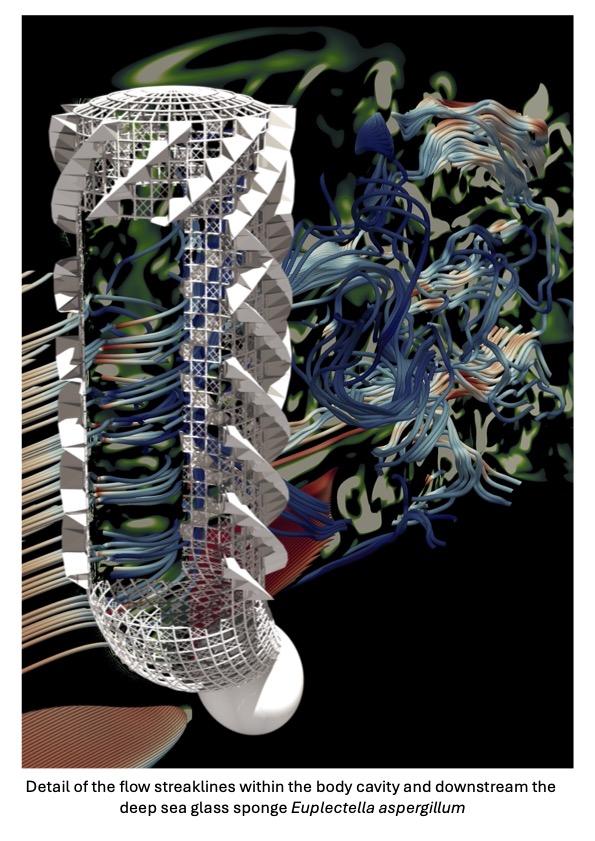Celebrating Excellence: The 2024 ASPEN Institute Italia Award for Supercomputer-driven Research
- /
- News
- /
- Celebrating Excellence: The 2024...

“Extreme flow simulations reveal skeletal adaptations of deep-sea sponges” and open up unprecedented perspectives for engineering design. This multidisciplinary study – at the frontiers of physics, biology, computer science and engineering – has won the ninth Aspen Institute Italia Award for scientific research and collaboration between Italy and the United States.
The winning project, conducted with Cineca’s Marconi100 supercomputer, illuminates the extraordinary adaptive capabilities of deep-sea sponges. The study, also published in the journal Nature, opens up new perspectives in the engineering design of low-resistance structures that adapt to air or water pressure, such as ships, aeroplane fuselages, and even innovative skyscrapers.
In particular, the species studied, Euplectella aspergillum—also known as Venus Flower Basket—is a sponge that lives deep in the Pacific Ocean and around Antarctica. It has exceptional structural properties. Its skeleton is made of silica, an element the sponge extracts from seawater, turning into very thin glass fibres. Hence, its nickname, “glass sponge.” An amazing feature of this inherently fragile structure is that it exhibits excellent mechanical strength due to its special structure and optimal mass distribution.
Following these insights, the scientists involved in this research project investigated the Venus Basket’s adaptations to the abyss currents through advanced fluid-dynamic simulations. They used the Marconi 100 supercomputer at CINECA, which reaches a computational speed of about 10 Petaflops and produces data in four dimensions: three spatial and one temporal.
Simulation with the Marconi100 supercomputer
The structure of Euplectella aspergillum, modelled by Pierluigi Fanelli of the University of Tuscia, is reminiscent of a delicate glass vase in the shape of a thin-walled cylindrical tube with a large central atrium composed of siliceous spicules. The spicules are composed of three perpendicular rays, giving them a six-pointed shape. The microscopic spicules ‘weave’ together a very dense mesh, which provides the sponge with a rigidity not found in other sponge species and allows them to survive at great depths in the ocean.
The researchers used a calculation code developed by Giorgio Amati from the HPC department of CINECA in Rome. The software enabled super-simulations based on the Lattice Boltzmann method, a class of computational fluid dynamics methods for complex systems that represents the fluid as a collection of particles and tracks the behaviour of each of them. The ‘in silico’ experiments, i.e., conducted through sophisticated computer simulations, reproduced the hydrodynamic conditions of the seabed where the glass sponge lives through almost 100 billion fluid particles.
The results compiled by Vesselin K. Krastev at the University of Rome ‘Tor Vergata’ allowed researchers to explore how the sponge’s organisation of holes and ridges improves its ability to reduce the forces applied by seawater and how its structure influences the dynamics of flow within the sponge’s body cavity, optimising both the selective filtration of nutrients and the meeting of gametes for sexual reproduction.
This work is an exemplary application of computational fluid dynamics, in general, and of the Lattice Boltzmann method, in particular: the accuracy and flexibility of the method, combined with access to one of the world’s best supercomputers, has enabled calculations to be performed at a level never before attempted in this field.
Thanks to supercomputing resources, this study paves the way for new investigations on the relationships between fluid mechanics, biology of living organisms, and ecology, with spin-off applications in prospective design and structural engineering.
This scientific endeavour won the 2024 Aspen Italia Award thanks to its indisputable value in transatlantic and interdisciplinary collaboration. The study features the University of Rome Tor Vergata, Harward and New York University. The latter contributed significantly to understanding the biological implications of super-simulation results.
The jury of the Award, chaired by the Hon. Prof. Giulio Tremonti, President of Aspen Institute Italia, recognised the innovative value of this research. Thanks to supercomputing resources, it opens up new perspectives in the field of the relationships between fluid mechanics, the biology of living organisms, and ecology, with concrete spin-offs for applications in design and structural engineering.